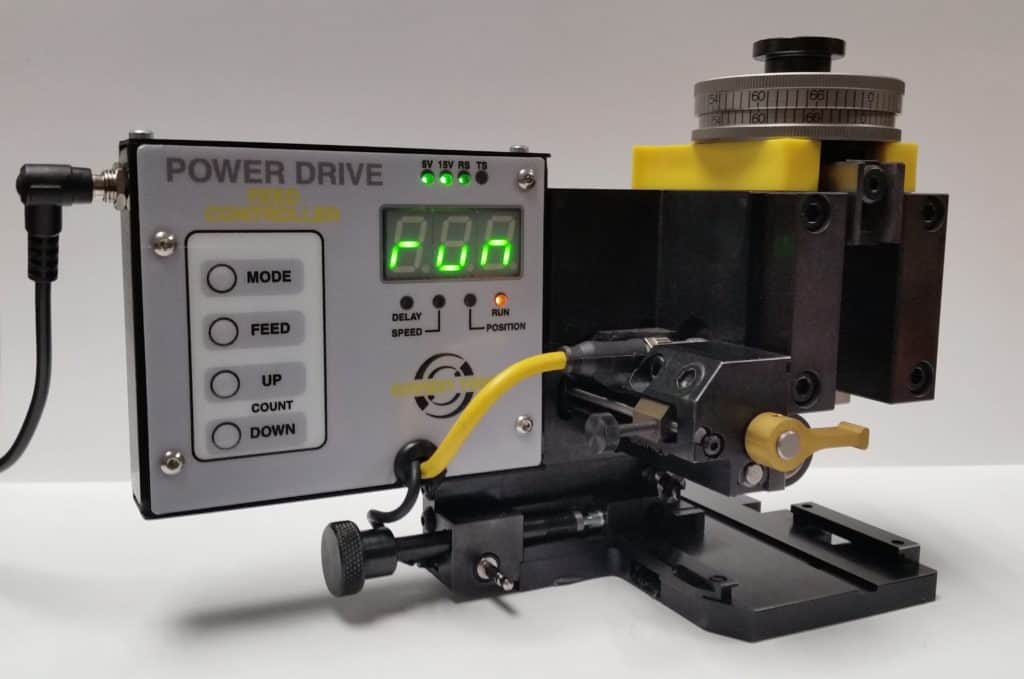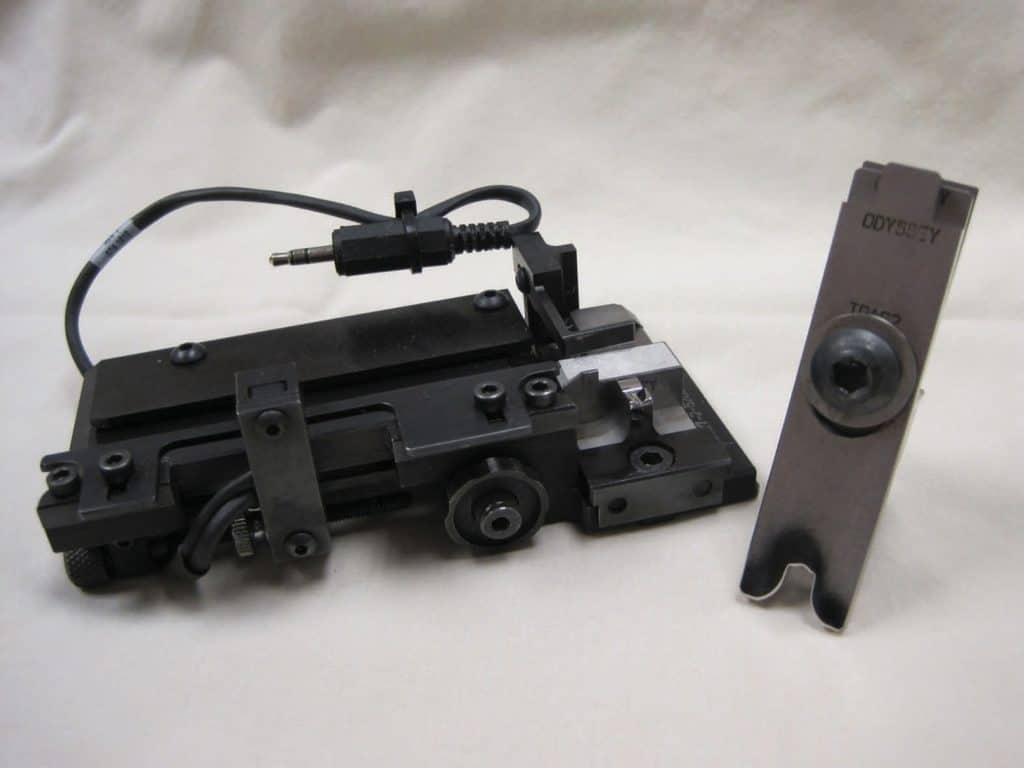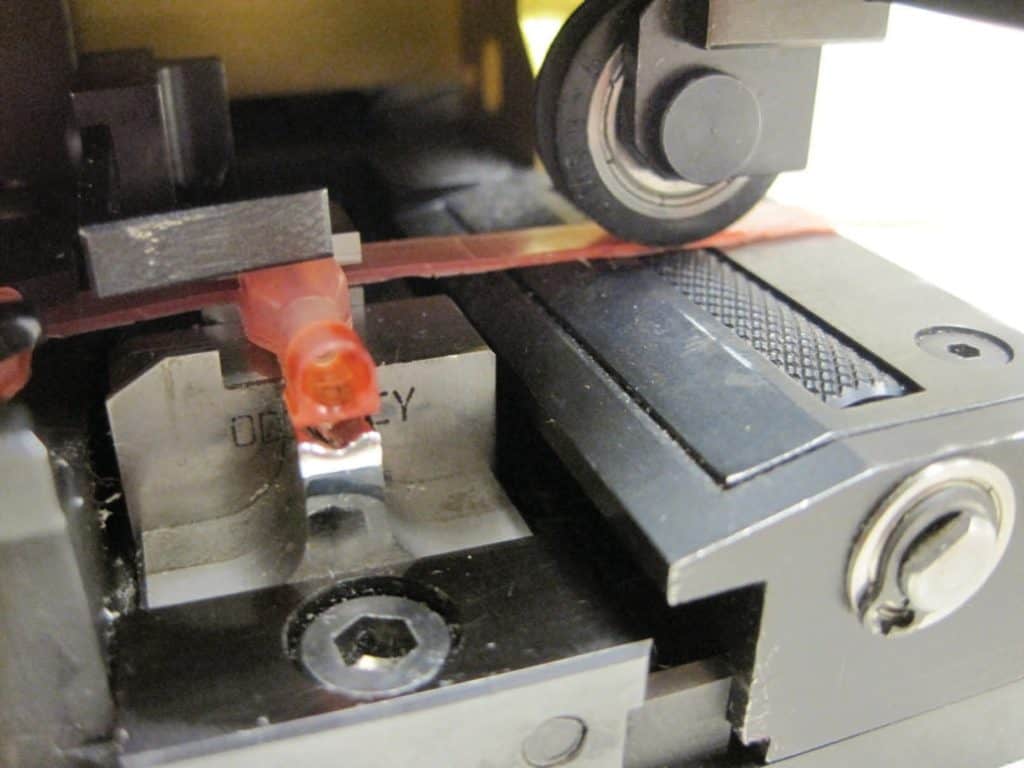As the journey into the twenty-first century is well underway, wire and cable shops are increasingly productive as a result of new and advanced technologies. Fully automated wire processing machines not only cut, strip and termi- nate wires, but can also double-terminate, twist, tin and plug! Some machines sense wire gauge and automatically adjust blades to achieve a perfect strip. Very sophisticated presses allow you to change press speed, monitor crimp integrity and automatically adjust crimp height. Wires can be labeled with jets of ink and stripped by beams of light.
Yes, the twenty-first century is indeed upon us… except when it comes to applicators. With few exceptions, appli- cators purchased or leased today rely on technologies developed decades ago. They’re held captive in the last cen- tury. Terminals are still fed using mechanical or pneumatic systems. This makes it difficult and time consuming to adjust the terminal position over the anvil and often forces operators to lower press speeds (and output) just to make the terminal feed properly. And given that only a handful of parts in a given applicator actually touch the terminal, why do you have to buy a complete applicator (body, ram, springs, etc.) for each new terminal? Why can’t applicators feed mylar tape consistently and reliably? And, most importantly, why do applicator costs rise dramatically year after year when the same old problems persist and opportunities to incorporate advanced tech- nologies are apparently ignored?
These are all good questions. Perhaps you have asked them yourself. Well, now there is an answer: Terminator with Power Drive by Odyssey Tool. Terminator is a left-to-right side feed applicator. It is similar to traditional applicators in that it includes a die body, ram, crimping blades, cutter and anvil. And it mounts in a variety of presses used in cable shops across America and the world. However, that’s where the similarities end. Terminator is very easy to use. It embodies twenty-first century technologies, including swappable tooling, microprocessor- based electronics, stepper motors, optical sensors and electronic control over feeding parameters. And, most im- portantly, Terminator saves you money. You get a better product at lower cost. To see how all of this is achieved, let’s start with the patented “tool pack”.

Tool Packs
To use Terminator to crimp a specific terminal, a tool pack must be installed. One tool pack consists of two pieces: upper tooling and lower tooling. The upper tooling installs in the ram with a single bolt. Although the upper tooling itself consists of several parts, all of those parts are retained using an E-clip. The clip keeps all of the parts together and in the correct orientation. The operator handles the upper tooling as a single part.
The lower tooling consists of the stock guide, terminal sensor, anvil and cutter. As is the case with the upper tool- ing, the lower tooling also consists of several parts. However, all of the parts are factory assembled on a plate, fully adjusted at the factory and handled as a single piece by an operator.
Swapping tool packs is easy and quick. Simply unbolt the upper tooling to remove it from the ram. To remove the lower tooling, unplug one cable, pull and twist a release knob to latch the knob in the “release” position and then slide the lower tooling out. That’s it. The “old” tool pack is now removed. To install the “new” tool pack, just reverse the process. With a little practice, tool packs can be swapped in less than a minute. Newly purchased tool packs are ready to go when you receive them because all adjustments are made at the factory. And because Termi- nator has an open face design, tool packs can be swapped without removing Terminator from the press.
The tool pack concept is an important advancement in applicator technology because TOOL PACKS SAVE YOU MONEY. You no longer need to purchase a complete applicator for each terminal or family of terminals. Instead, you need purchase only those parts and pieces that are unique to the terminal- not the complete applicator.
Given that the tool pack concept is a very effective way to lower tooling costs, why hasn’t it been available sooner? Why haven’t traditional applicators embraced the tool pack concept? It’s because traditional applicators use traditional methods to feed terminals into position over the anvil. When a mechanical or pneumatic feeding system acts on the terminal pre-termination (that is, while the terminal is still attached to the carrier strip), it is very difficult to design tool packs that are easily and quickly swappable. The feeding system gets in the way. Termina- tor solves the feeding problem using Power Drive.

Power Drive
Power Drive is a patented terminal feeding system that uses what other applicators throw away. During each crimp cycle, Terminator does not cut the carrier strip. Instead, it is left intact and captured between pinch rollers. The pinch rollers consist of one idler roller and one driven roller. The idler roller presses the carrier strip firmly against the driven roller. The driven roller is powered by a stepper motor through a transmission.
Each terminal feeding cycle positions the next terminal to be crimped in a graceful, smooth and precise manner. As the press raises the ram, a ram sensor generates a signal that triggers a feeding cycle. The stepper motor is acti- vated to begin feeding the next terminal toward the anvil. An optical sensor on the lower tooling (terminal sensor) generates a signal as terminals pass through the sensor (or as holes in the carrier strip pass the sensor). The termi- nal sensor signal provides a reference that is used to precisely position the next terminal over the anvil.
Traditional applicators, using either mechanical or pneumatic means, feed terminals by engaging a feed pawl in a hole in the carrier strip or pressing a feed pawl directly against the terminal. As a result, the feeding system in each applicator must be adapted to accommodate the terminal or the carrier strip. This is one reason why you must pur- chase a complete applicator for each terminal. Power Drive is different. The size and shape of the terminal does- n’t matter because, at the point feeding actually occurs, the terminal is gone! And because the pinch rollers rely on pressure contact on the carrier strip, it doesn’t matter if the carrier strip is thick or thin… wide or narrow… plastic or metal… has holes or doesn’t have holes. It just doesn’t matter. Power Drive is the most universal terminal feeding system ever developed.
Power Drive is what makes the tool pack concept possible. Power Drive is highly universal. Are there other bene- fits? Read on.

So Easy to Use
The “brains” behind Power Drive is contained in a microprocessor embedded in the electronics contained in Ter- minator. Terminator does not need a data link to a “smarter” device to operate. Because Power Drive is controlled electronically, many benefits not found in traditional applicators are possible. A feed controller containing four control pushbuttons and a 3 digit display allow an operator to do the following:
Speed: One of nine terminal feeding speeds can be selected ranging from .25 inches/second to 3 inches/ second.
Delay: Terminator initiates a feed cycle when the press raises the ram. If desired, feeding can begin im- mediately after the ram rises. However, in some cases, a delay is necessary to allow time for a machine or an operator to clear the just-crimped wire from the crimping area. Ten delay settings are available rang- ing from 0 seconds to 5 seconds.
Position: Terminal position can be adjusted in steps of .001” over a range of +/- .050”. Typically, no position adjustment is needed but is available to enable an operator to easily remove a roll in the crimp or to accommodate worn tooling.
Feed Count: The number of feed cycles is tallied and stored in a non-volatile memory that cannot be re- set. The feed count can be monitored using the feed controller to facilitate preventive maintenance.
An Applicator for the Times
Are you tired of slowing down press speed to solve feeding problems? Tired of positioning errors as a reel changes from full to empty? Tired of mylar tape getting jammed and torn? Tired of receiving brand new applica- tors that need feed adjustments immediately out of the box? Tired of paying too much for your applicators?
If you answered yes to any of these questions, take a look at Terminator with Power Drive by Odyssey Tool. You can see it in action at www.terminatorpd.com or contact Odyssey Tool (sales@odysseytool.com , 586-468-6696 (phone), 586-468-8422 (fax)) for additional information.
Come join us in the twenty first century.
